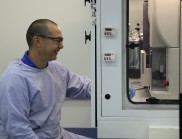New antivirals closer with opening of new laboratory
CSIRO and Deakin University today officially open the new high-tech national research facility, located inside the Australian Animal Health Laboratory (AAHL) in Geelong.
Dr Kurt Zuelke, director of AAHL, said the new laboratory will provide more specialised techniques, at a cellular level, to help pin-point the immune mechanisms employed by various animal hosts.
“This new world-class facility will be critical in helping us develop new, more natural, therapeutics and boost our work in preventing, detecting and treating emerging infectious diseases,” Dr Zuelke said.
“This new world-class facility will be critical in helping us develop new, more natural, therapeutics and boost our work in preventing, detecting and treating emerging infectious diseases.”
Dr Kurt Zuelke, director of AAHL
“Researchers in Geelong are already world renowned for their work with zoonotic agents – those that can pass from animals to people – and with this new facility we can now compare the immune responses of different animal species, including humans, to the most pathogenic infectious agents,” he said.
By understanding how pathogens affect different hosts, for example, how pigs or poultry protect themselves from influenza, researchers hope to harness a host’s successful immune mechanisms to develop new therapeutic approaches to manage these viruses.
The new laboratory is equipped with state-of-the-art equipment, thanks to a long standing collaboration between CSIRO and Deakin University, with input from the University of Georgia, USA. It will be made available as a national resource with operational funding support from the National Collaborative Research Infrastructure Strategy (NCRIS).
“We’re already in discussions with international researchers from the United Kingdom and USA who are keen to have access to this facility to further their research into diseases of pigs,” Dr Zuelke said.
Having access to a comparative immunology laboratory of this calibre will enable research scientists from across the world to work on infected live cells, all contained within the quarantined biosecure area of one of the world’s most sophisticated high-containment laboratories.
Media resources
Click image for high resolution version.


